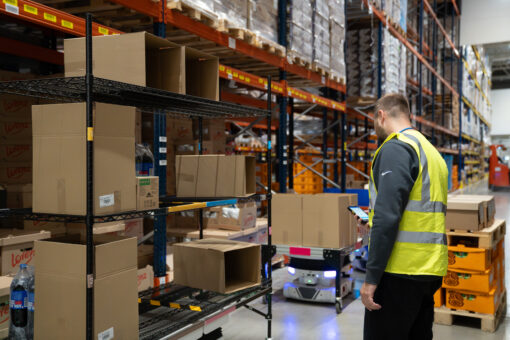WP: How to achieve 400 UPH with Locus Fast Pick
WP: How to achieve 400 UPH with Locus Fast Pick Download Now!
4 Top Logistics Myths about AI and Robotics Demystified
Jorge Múgica, Iberia Business Development Manager

In recent years, the implementation of robotics has transformed the logistics industry, improving efficiency and precision in processes. The use of autonomous mobile robots (AMRs) and the application of technologies such as Artificial Intelligence (AI) in the sector have gained special prominence and are increasingly common. However, despite the numerous advantages that robotics brings to the industry, several myths continue to exist that question the revolutionary capacity of this type of innovation.
Myth 1. Worker Layoffs
Without a doubt, one of the most common myths about robotics or the application of AI in any industry is that they encourage layoffs and will cause a substantial loss of jobs for human workers. However, the objective of these use cases is not to replace associates within warehouses, but rather to increase their capabilities and improve their conditions while achieving business expansion.
Implementing automated solutions in warehouses delegates the most tedious, routine, and physically exhausting parts of the job to robots, allowing associates to focus on more strategic and rewarding tasks. Therefore, it is not about doing away with jobs, but rather about altering the distribution and organization of tasks. The fact that people can focus on tasks that require their logic and brains will promote greater job satisfaction and, in the same way, increase employee retention rates, improve working conditions, and promote growth.
Myth 2. Unaffordable Costs
It is also often mentioned that the introduction of robotics can involve a huge financial investment. This is not always true. It should be noted that, although the introduction of this type of solution requires a certain investment, it generates significant savings in the long term, given the improved productivity received in return.
Fortunately, in today’s market we can find many affordable options, which makes robotics accessible to small and medium-sized businesses as well as the largest warehouse. In fact, many companies dedicated to robotics propose flexible subscription models that adapt to different needs, thus reducing barriers to entry at crucial moments for business such as end-of-year campaigns.
The minimal initial investment for a subscription robotics model means a simpler budget approval process for companies and drastically reduces ROI time from years to months. By paying a monthly fee, this disbursement becomes an OpEx and not a CapEx investment, as well as an ideal solution to automate in an economic period like this, of greater uncertainty or changes.
Locus’ robots-as-a-service (RaaS) option is unique because, unlike other companies that set up something like leases or finance the purchase of robots, we own the robots outright, so our customers have maximum flexibility at all times. This flexibility allows for the improvement of warehouse infrastructure, while also helping to manage inventory optimization and slotting or optimizing robot operations.
Myth 3. Long Implementation Periods
The reality of any type of technological solution is that it requires small changes in the structure of the warehouses, from sealing systems, extensive rail structures, etc. Therefore, values such as flexibility when adopting innovation are essential so that the effort is worthwhile and can be translated into benefits.
For that reason, some companies, such as Locus Robotics, offer a flexible, scalable, and cost-effective solution capable of integrating perfectly with your warehouse management system within just a matter of weeks. The Locus solution doesn’t require any changes to your existing infrastructure or workflow.
Myth 4. Inaccurate Processes and Data
The last myth is that robots or AI are prone to making mistakes and disrupting logistics operations. As AI and machine learning technologies advance, robots can collect and analyze large amounts of data to constantly optimize warehouse operations. This provides managers with access to actionable information that they can use to increase efficiency.
Precisely, AI and other technologies such as machine learning offer companies powerful predictive analytics that transform manufacturing supply chain management by improving the accuracy and speed of forecasts. This technology promotes better decision making for companies by reducing operating costs and being applied to inventory management, demand forecasting, cargo route planning, and much more.
Remember, it is important to face all changes with an open mind. Process automation has completely transformed the logistics industry by improving productivity in warehouses. When you accept the complementary role of robots or tools such as AI within logistics, you will be able to drive the industry towards a more efficient future.
Want to learn how AI-powered robots can help improve your warehouse operations? Let’s talk!
This article was originally published in Spanish in “El Candelero Tecnológico.”




